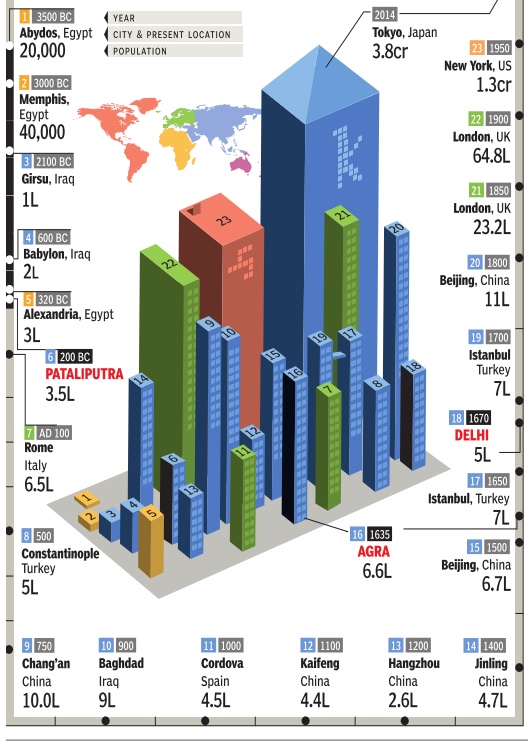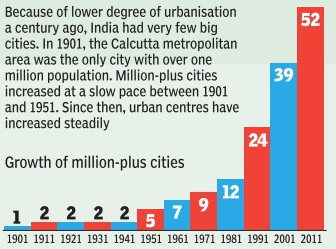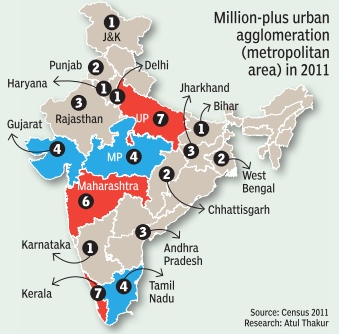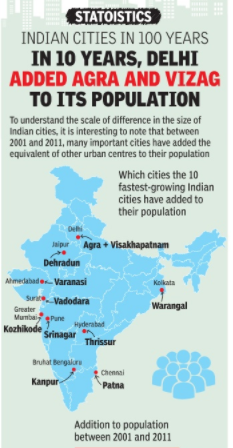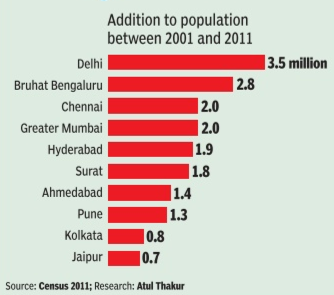Cities of India: growth
(→1901-2011) |
(→…for 2019- 35) |
||
| (12 intermediate revisions by 2 users not shown) | |||
| Line 3: | Line 3: | ||
[[Category: Economy-Industry-Resources|C]] | [[Category: Economy-Industry-Resources|C]] | ||
[[Category: Places |C]] | [[Category: Places |C]] | ||
| + | |||
=Growth of cities= | =Growth of cities= | ||
| + | ==History: I== | ||
''' SIZE IN THE CITY ''' [http://epaperbeta.timesofindia.com/Article.aspx?eid=31808&articlexml=STATOISTICS-SIZE-IN-THE-CITY-04122014009044 ''The Times of India''] Dec 04 2014 | ''' SIZE IN THE CITY ''' [http://epaperbeta.timesofindia.com/Article.aspx?eid=31808&articlexml=STATOISTICS-SIZE-IN-THE-CITY-04122014009044 ''The Times of India''] Dec 04 2014 | ||
| Line 12: | Line 14: | ||
By the mid 19th century, industrialization started counting, with London and New York as the largest cities. Finally, in the modern era, Tokyo became the world's largest city, a title it holds to this day. | By the mid 19th century, industrialization started counting, with London and New York as the largest cities. Finally, in the modern era, Tokyo became the world's largest city, a title it holds to this day. | ||
| + | |||
| + | ==History: II== | ||
| + | [[File: 3,500 BC to A.D. 2018- the growth of large cities in India, China and the world.jpg|3,500 BC to A.D. 2018: the growth of large cities in India, China and the world <br/> From: [https://epaper.timesgroup.com/Olive/ODN/TimesOfIndia/shared/ShowArticle.aspx?doc=TOIDEL%2F2018%2F05%2F14&entity=Ar00711&sk=059A7257&mode=image May 14, 2018: ''The Times of India'']|frame|500px]] | ||
| + | |||
| + | '''See graphic''': | ||
| + | |||
| + | ''3,500 BC to A.D. 2018: the growth of large cities in India, China and the world'' | ||
| + | |||
| + | ==History: III== | ||
| + | [[File: 1500-2019- How cities in India and the world grew and shrunk over six centuries.jpg|1500-2019: How cities in India and the world grew and shrunk over six centuries <br/> From: [https://epaper.timesgroup.com/Olive/ODN/TimesOfIndia/shared/ShowArticle.aspx?doc=TOIDEL%2F2019%2F07%2F31&entity=Ar00401&sk=111B630F&mode=image July 31, 2019: ''The Times of India'']|frame|500px]] | ||
| + | |||
| + | '''See graphic''': | ||
| + | |||
| + | '' 1500-2019: How cities in India and the world grew and shrunk over six centuries '' | ||
| + | |||
| + | [[Category:Development|C | ||
| + | CITIES OF INDIA: GROWTH]] | ||
| + | [[Category:Economy-Industry-Resources|C | ||
| + | CITIES OF INDIA: GROWTH]] | ||
| + | [[Category:India|C | ||
| + | CITIES OF INDIA: GROWTH]] | ||
| + | [[Category:Pages with broken file links|CITIES OF INDIA: GROWTH]] | ||
| + | [[Category:Places|C | ||
| + | CITIES OF INDIA: GROWTH]] | ||
| + | |||
| + | ==2014-16: growth in employment, per capita income== | ||
| + | [[File: Global Economic Performance Index Rank- Delhi, Hyderabad, Surat.jpg|Global Economic Performance Index Rank- Delhi, Hyderabad, Surat <br/> From: [https://epaper.timesgroup.com/Olive/ODN/TimesOfIndia/shared/ShowArticle.aspx?doc=TOIDEL%2F2018%2F09%2F25&entity=Ar00107&sk=8B1C98A3&mode=text September 25, 2018: ''The Times of India'']|frame|500px]] | ||
| + | |||
| + | '''See graphic''': | ||
| + | |||
| + | ''Global Economic Performance Index Rank- Delhi, Hyderabad, Surat'' | ||
| + | |||
| + | |||
| + | Delhi is undoubtedly India’s economic capital too. In a global ranking of 300 fastest growing and best performing metro areas, the capital ranked 6th, just behind Beijing. The national capital region generated over 6 lakh jobs during 2014-16 and its per capita income rose 6.6%, according to a Brookings study titled Global Metro Monitor. Among nine Indian metro areas included in the city, Delhi was the best performer by a big margin | ||
| + | |||
| + | ==India’s 6 fastest growing cities, 2016 – (projection:) 2021== | ||
| + | [http://epaperbeta.timesofindia.com/Article.aspx?eid=31808&articlexml=Delhi-Indias-largest-Asias-fastest-growing-city-10082017004027 Delhi India's largest, Asia's fastest growing city, August 10, 2017: The Times of India] | ||
| + | [[File: The fastest growing cities of India, China and rest of Asia, 2016, (projection) 2021.jpg|The fastest growing cities of India, China and rest of Asia, 2016, (projection) 2021; [http://epaperbeta.timesofindia.com/Article.aspx?eid=31808&articlexml=Delhi-Indias-largest-Asias-fastest-growing-city-10082017004027 Delhi India's largest, Asia's fastest growing city, The Times of India], August 10, 2017|frame|500px]] | ||
| + | |||
| + | '''See graphic''': ''The fastest growing cities of India, China and rest of Asia, 2016, (projection) 2021 '' | ||
| + | |||
| + | |||
| + | Delhi will have the fastest growth of any city in Asia, with the economy of the city-state likely to become almost 50% larger in 2021 than it was at the end of last year. | ||
| + | Indian cities are set to expand the most across the Asian region, with growth speeding up from the past five years, according to a new study from Oxford Economics, which has ranked Asia's 30 largest cities. | ||
| + | |||
| + | With financial and business services projected to be the fastest growing sector in India, the capital's dominance in this industry will lead to higher growth and higher incomes. | ||
| + | |||
| + | “Limits on foreign ow nership of Indian companies are gradually being reduced or eliminated,“ wrote Mark Britton, lead economist on the report. “In the short term, this is conducive to strong growth in Delhi's professional services sector, as overseas investors seek advice on possible deals, while in the long term, it should mean steady income streams for such businesses.“ | ||
| + | |||
| + | Consumer companies such as Japan's Muji are also betting on such a change. Muji's parent company , Ryohin Keikaku Co, sees India becoming its second largest international market, after China. There is also Amazon.com Inc's Indian unit, which is seeking approval to invest in a food supply chain and take advantage of government moves to ease rules on foreign retailers. | ||
| + | |||
| + | China's expansion is likely to slow, although the largest five cities there will still be recording growth rates of 6% or more. There will be a slight slowdown across the region amid moderating import demand from China, with growth expected to average 4.2% per year over the next five years up to 2021, down from 4.5% in 2012-2016. | ||
| + | |||
| + | Even so, that growth is still much faster than in the developed economies and cities in the region -and that's a big opportunity for companies. Starbucks Corp plans to almost double the number of stores it has in mainland China by 2021, while McDonald's Corp plans to add 2,000 new restaurants over the same period. | ||
| + | |||
| + | Both companies recently announced they were buying out their partners in Mainland China and taking control of operations. | ||
| + | |||
| + | However, there are significant differences across the Asian region. Japanese cities are likely to remain at the bottom of the growth table amid a challenging demographic outlook, with Osaka last in the rankings as its working-age population falls by approximately 1% per year, the report said. | ||
| + | |||
| + | Tianjin is forecast to clock the fastest growth in China, given that it has a large manufacturing base and one of the nation's busiest ports. However, as the services sector expands, the manufacturing and shipping industries may prove to be less supportive in future. | ||
| + | |||
| + | Ho Chi Minh, the largest metro in Vietnam, was the only non-Indian city in the top five, reflecting the city's success in establishing itself as a manufacturing centre, as well as its strong services sector. | ||
=Cities with a population of 10 lakh= | =Cities with a population of 10 lakh= | ||
| Line 18: | Line 82: | ||
[http://epaperbeta.timesofindia.com/Article.aspx?eid=31808&articlexml=STATOISTICS-INDIAN-CITIES-IN-100-YEARS-MILLION-PEOPLE-12072017009028 Statoistics - Indian Cities In 100 Years Million-People Metros Grew From One To 52|Times of India] | [http://epaperbeta.timesofindia.com/Article.aspx?eid=31808&articlexml=STATOISTICS-INDIAN-CITIES-IN-100-YEARS-MILLION-PEOPLE-12072017009028 Statoistics - Indian Cities In 100 Years Million-People Metros Grew From One To 52|Times of India] | ||
| − | [[File:cities.PNG |The increase in the number of Indian cities with a population of 10 lakh, or more, 1901-2011|frame|500px]] | + | [[File:cities.PNG |The increase in the number of Indian cities with a population of 10 lakh, or more, 1901-2011- I|frame|500px]] |
| + | [[File:cities1.PNG |The increase in the number of Indian cities with a population of 10 lakh, or more, 1901-2011- II|frame|500px]] | ||
| + | |||
| + | '''See graphics''': | ||
| + | |||
| + | 1. ''The increase in the number of Indian cities with a population of 10 lakh, or more, 1901-2011- I'' | ||
| + | |||
| + | 2. ''The increase in the number of Indian cities with a population of 10 lakh, or more, 1901-2011- II'' | ||
| + | |||
| + | ==2001-11: the fastest growing cities== | ||
| + | [http://epaperbeta.timesofindia.com/Gallery.aspx?id=13_07_2017_009_028_001&type=P&artUrl=STATOISTICS-INDIAN-CITIES-IN-100-YEARS-IN-10-13072017009028&eid=31808 ‘The fastest growing cities of India, 2001-11’|Times of India] | ||
| + | [[File:cityyyyy.PNG |The ten fastest growing cities of India, 2001-11- I|frame|500px]] | ||
| + | [[File:cityyyyy1.PNG |The ten fastest growing cities of India, 2001-11- II|frame|500px]] | ||
| + | |||
| + | '''See graphics''': | ||
| + | |||
| + | ''The ten fastest growing cities of India, 2001-11- I'' | ||
| + | |||
| + | ''The ten fastest growing cities of India, 2001-11- II'' | ||
| + | |||
| + | =Growth projections= | ||
| + | ==…for 2019- 35== | ||
| + | [https://epaper.timesgroup.com/Olive/ODN/TimesOfIndia/shared/ShowArticle.aspx?doc=TOIDEL%2F2018%2F12%2F07&entity=Ar00501&sk=9B965D3A&mode=text Surojit Gupta, ‘17 of 20 fastest-growing cities in the world will be from India’, December 7, 2018: ''The Times of India''] | ||
| + | |||
| + | [[File: The 10 Indian cities projected to grow the fastest between 2019 and 2035.jpg|The 10 Indian cities projected to grow the fastest between 2019 and 2035 <br/> From: [https://epaper.timesgroup.com/Olive/ODN/TimesOfIndia/shared/ShowArticle.aspx?doc=TOIDEL%2F2018%2F12%2F07&entity=Ar00501&sk=9B965D3A&mode=text Surojit Gupta, ‘17 of 20 fastest-growing cities in the world will be from India’, December 7, 2018: ''The Times of India'']|frame|500px]] | ||
| + | |||
| + | ''Surat, Agra And Bengaluru To Make Up Top 3'' | ||
| + | |||
| + | The list of cities expected to grow the fastest in terms of GDP is dominated by India, with 17 among the top 20 cities in the world, according to a global economic research report. | ||
| + | |||
| + | “When future GDP growth rates are compared, the story is mostly very different. In particular, 17 of the 20 fastest-growing cities in the world between 2019 and 2035 will be Indian, with Bengaluru, Hyderabad and Chennai among the strongest performers,” said a report from Oxford Economics, a research house engaged in quantitative analysis. | ||
| + | |||
| + | Surat tops the list of top 10 fastest growing cities in the world between 2019 and 2035, followed by Agra and Bengaluru. Hyderabad is in fourth place, followed by Nagpur, Tirupur, Rajkot, Tiruchirappalli, Chennai and Vijayawada. Surat is a major diamond trading and processing centre and also has a strong IT sector. | ||
| + | |||
| + | Bengaluru, Hyderabad and Chennai are best known as technology hubs and home to large financial services firms. Outside of India, Phnom Penh is the fastestgrowing city in the world in the 2019-2035 forecast, with Dar es Salaam the leader among African cities. | ||
| + | |||
| + | In terms of population in 2035, Mumbai figures in the top 10 cities. “By 2035, the combined GDP of Indian cities will still be small compared with Chinese (or, indeed, North American and European) cities. However, in terms of GDP growth, it is Indian cities that are star performers in our forecast,” said Richard Holt, head of global cities research at Oxford Economics. | ||
| + | |||
| + | |||
| + | '''NY to remain largest urban eco: Study''' | ||
| + | |||
| + | However, Chinese cities will contribute significantly when it comes to aggregate GDP. | ||
| + | |||
| + | Shanghai will join London as the world’s fourth-largest urban economy in 2035. | ||
| + | |||
| + | According to the forecast, in 2027, the aggregate GDP of all Asian cities will for the first time exceed the combined GDP of all North American and European cities. | ||
| + | |||
| + | “By 2035, we project it will be 17% higher, with Chinese cities alone generating more output than all cities in North America or Europe,” the report said. | ||
| + | |||
| + | New York will still be the largest urban economy in the world in 2035, with the largest finance and business services sector. It will be followed by Tokyo and Los Angeles, with Shanghai tied with London for the fourth place, the report said. The research house said the modelling and results in the report were based on information provided by third parties, “upon which Oxford Economics has relied in producing its report and forecasts in good faith”. | ||
| + | |||
| + | |||
| + | ===B=== | ||
| + | [[File: The Indian (and international) cities projected to grow the fastest between 2019 and 2035.jpg|The Indian (and international) cities projected to grow the fastest between 2019 and 2035 <br/> From: [https://epaper.timesgroup.com/Olive/ODN/TimesOfIndia/shared/ShowArticle.aspx?doc=TOIDEL%2F2019%2F12%2F27&entity=Ar00400&sk=6A55AC03&mode=image Dec 27, 2019 ''The Times of India'']|frame|500px]] | ||
| + | |||
| + | '''See graphic''': | ||
| + | |||
| + | '' The Indian (and international) cities projected to grow the fastest between 2019 and 2035 '' | ||
| + | |||
| + | [[Category:Development|CCITIES OF INDIA: GROWTH | ||
| + | CITIES OF INDIA: GROWTH]] | ||
| + | [[Category:Economy-Industry-Resources|CCITIES OF INDIA: GROWTH | ||
| + | CITIES OF INDIA: GROWTH]] | ||
| + | [[Category:India|CCITIES OF INDIA: GROWTH | ||
| + | CITIES OF INDIA: GROWTH]] | ||
| + | [[Category:Pages with broken file links|CITIES OF INDIA: GROWTH | ||
| + | CITIES OF INDIA: GROWTH]] | ||
| + | [[Category:Places|CCITIES OF INDIA: GROWTH | ||
| + | CITIES OF INDIA: GROWTH]] | ||
| + | |||
| + | =Air services as a developmental indicator= | ||
| + | [https://epaper.timesgroup.com/Olive/ODN/TimesOfIndia/shared/ShowArticle.aspx?doc=TOIDEL%2F2018%2F08%2F17&entity=Ar00401&sk=6C8EE200&mode=text WHAT FLIGHTS TO A MEGACITY TELL US ABOUT ITS ECONOMY, August 17, 2018: ''The Times of India''] | ||
| + | |||
| + | [[File: The population of the biggest cities of the world (especially Bangladesh and India) vis-à-vis the number of daily aeroplane flights to those cities; The growth of the population of these cities, vis-à-vis the growth of their economies.jpg|i) The population of the biggest cities of the world (especially Bangladesh and India) vis-à-vis the number of daily aeroplane flights to those cities; <br/> ii) The growth of the population of these cities, vis-à-vis the growth of their economies; <br/> From: [https://epaper.timesgroup.com/Olive/ODN/TimesOfIndia/shared/ShowArticle.aspx?doc=TOIDEL%2F2018%2F08%2F17&entity=Ar00401&sk=6C8EE200&mode=text WHAT FLIGHTS TO A MEGACITY TELL US ABOUT ITS ECONOMY, August 17, 2018: ''The Times of India'']|frame|500px]] | ||
| + | |||
| + | |||
| + | A city is often measured in terms of its GDP, trade, investment. Another way is also to look at the frequency of flights in and out of there. Such a study of flight traffic by The Pudding shows how cities remain unconnected and underdeveloped though growing in number of inhabitants. Population growth without economic growth is ending up creating unsustainable megacities that can neither feed nor house its people. Here’s why a growing city isn’t always good news… | ||
=See also= | =See also= | ||
[[ Cities of India: the best and the worst ]] | [[ Cities of India: the best and the worst ]] | ||
| − | [[ | + | [[ Cleanliness ranks of Indian cities, districts: 2014-15 ]] |
| + | |||
| + | [[ Cleanliness ranks of Indian cities, districts: 2016 ]] | ||
| + | |||
| + | [[ Cleanliness ranks of Indian cities, districts: 2017]] | ||
| + | |||
| + | [[ Cleanliness ranks of Indian cities, districts: 2018]] | ||
[[ Cities of India: issues ]] | [[ Cities of India: issues ]] | ||
| + | |||
| + | [[Cities of India: growth]] | ||
| + | |||
| + | [[Housing: India]] | ||
| + | |||
| + | [[Housing and urban affairs: India]] | ||
| + | |||
| + | [[Urban development: India]] | ||
Latest revision as of 21:08, 28 February 2022
Contents |
[edit] Growth of cities
[edit] History: I
SIZE IN THE CITY The Times of India Dec 04 2014
Research: Dake Kang
I n 1974, Tertius Chandler came out with his groundbreaking book, “3000 years of urban growth“, which estimated the sizes of urban areas throughout history for the first time. It is now regarded as a classic. The earliest large cities were in today's Iraq and Egypt, reflecting the ancient Egyptian and Mesopotamian civilizations. Then came Pataliputra, with the rise of the Maurya Empire. Around 1 AD, the Roman empire came to the forefront, followed by the Byzantines. In the early Middle Ages, the Muslim empires became prominent with Baghdad and Cordoba, followed by China, which held the title for half a millennia. India got back to the forefront with the Mughal empire's capitals Agra and Delhi.
By the mid 19th century, industrialization started counting, with London and New York as the largest cities. Finally, in the modern era, Tokyo became the world's largest city, a title it holds to this day.
[edit] History: II
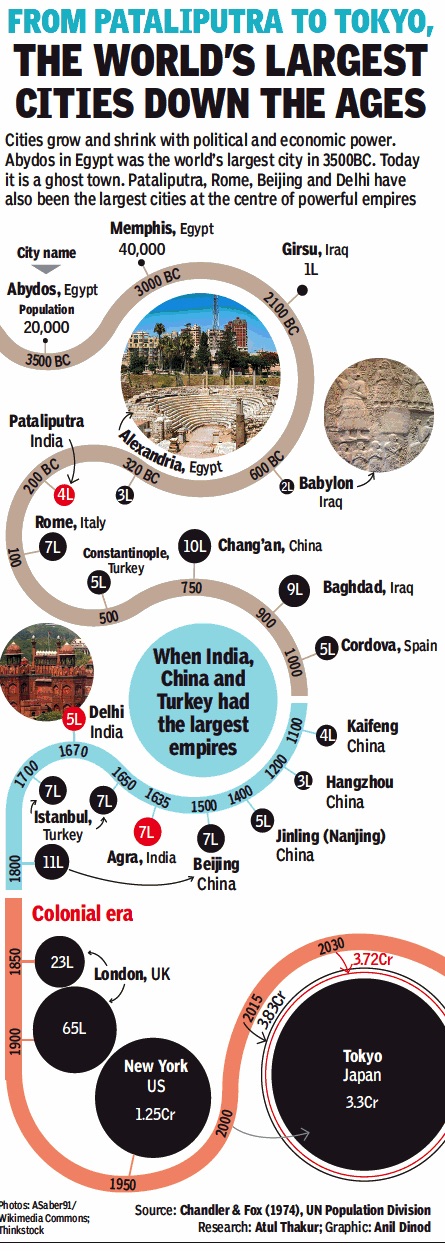
From: May 14, 2018: The Times of India
See graphic:
3,500 BC to A.D. 2018: the growth of large cities in India, China and the world
[edit] History: III
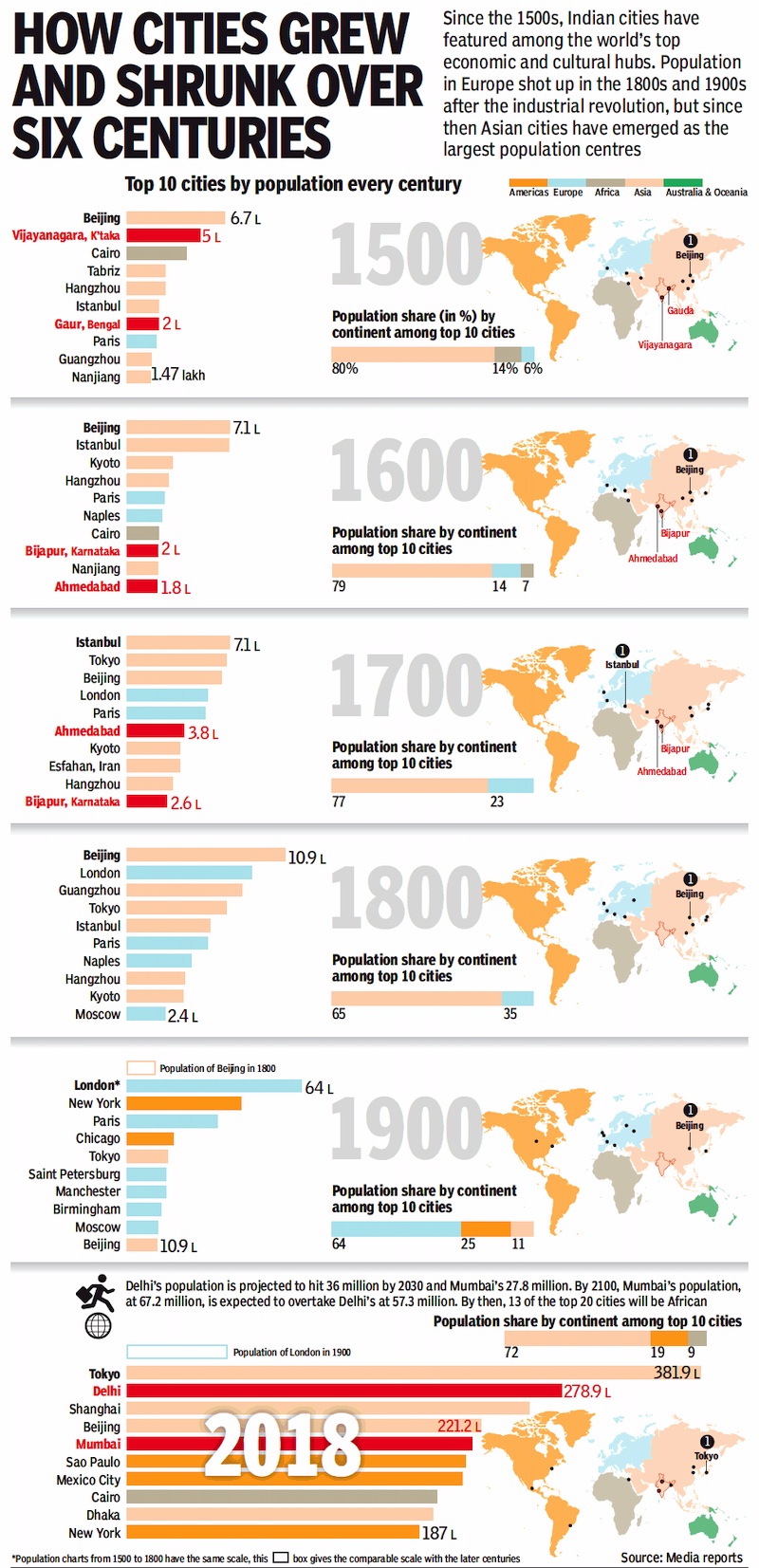
From: July 31, 2019: The Times of India
See graphic:
1500-2019: How cities in India and the world grew and shrunk over six centuries
[edit] 2014-16: growth in employment, per capita income
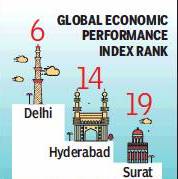
From: September 25, 2018: The Times of India
See graphic:
Global Economic Performance Index Rank- Delhi, Hyderabad, Surat
Delhi is undoubtedly India’s economic capital too. In a global ranking of 300 fastest growing and best performing metro areas, the capital ranked 6th, just behind Beijing. The national capital region generated over 6 lakh jobs during 2014-16 and its per capita income rose 6.6%, according to a Brookings study titled Global Metro Monitor. Among nine Indian metro areas included in the city, Delhi was the best performer by a big margin
[edit] India’s 6 fastest growing cities, 2016 – (projection:) 2021
Delhi India's largest, Asia's fastest growing city, August 10, 2017: The Times of India
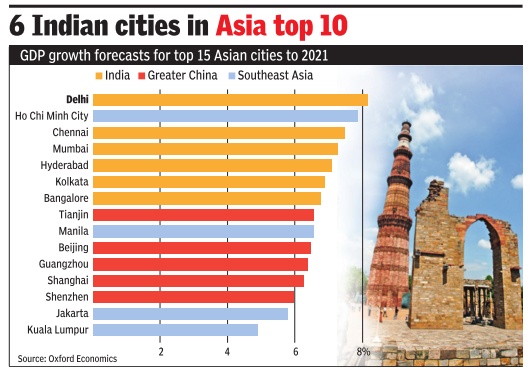
See graphic: The fastest growing cities of India, China and rest of Asia, 2016, (projection) 2021
Delhi will have the fastest growth of any city in Asia, with the economy of the city-state likely to become almost 50% larger in 2021 than it was at the end of last year.
Indian cities are set to expand the most across the Asian region, with growth speeding up from the past five years, according to a new study from Oxford Economics, which has ranked Asia's 30 largest cities.
With financial and business services projected to be the fastest growing sector in India, the capital's dominance in this industry will lead to higher growth and higher incomes.
“Limits on foreign ow nership of Indian companies are gradually being reduced or eliminated,“ wrote Mark Britton, lead economist on the report. “In the short term, this is conducive to strong growth in Delhi's professional services sector, as overseas investors seek advice on possible deals, while in the long term, it should mean steady income streams for such businesses.“
Consumer companies such as Japan's Muji are also betting on such a change. Muji's parent company , Ryohin Keikaku Co, sees India becoming its second largest international market, after China. There is also Amazon.com Inc's Indian unit, which is seeking approval to invest in a food supply chain and take advantage of government moves to ease rules on foreign retailers.
China's expansion is likely to slow, although the largest five cities there will still be recording growth rates of 6% or more. There will be a slight slowdown across the region amid moderating import demand from China, with growth expected to average 4.2% per year over the next five years up to 2021, down from 4.5% in 2012-2016.
Even so, that growth is still much faster than in the developed economies and cities in the region -and that's a big opportunity for companies. Starbucks Corp plans to almost double the number of stores it has in mainland China by 2021, while McDonald's Corp plans to add 2,000 new restaurants over the same period.
Both companies recently announced they were buying out their partners in Mainland China and taking control of operations.
However, there are significant differences across the Asian region. Japanese cities are likely to remain at the bottom of the growth table amid a challenging demographic outlook, with Osaka last in the rankings as its working-age population falls by approximately 1% per year, the report said.
Tianjin is forecast to clock the fastest growth in China, given that it has a large manufacturing base and one of the nation's busiest ports. However, as the services sector expands, the manufacturing and shipping industries may prove to be less supportive in future.
Ho Chi Minh, the largest metro in Vietnam, was the only non-Indian city in the top five, reflecting the city's success in establishing itself as a manufacturing centre, as well as its strong services sector.
[edit] Cities with a population of 10 lakh
[edit] 1901-2011
Statoistics - Indian Cities In 100 Years Million-People Metros Grew From One To 52|Times of India
See graphics:
1. The increase in the number of Indian cities with a population of 10 lakh, or more, 1901-2011- I
2. The increase in the number of Indian cities with a population of 10 lakh, or more, 1901-2011- II
[edit] 2001-11: the fastest growing cities
‘The fastest growing cities of India, 2001-11’|Times of India
See graphics:
The ten fastest growing cities of India, 2001-11- I
The ten fastest growing cities of India, 2001-11- II
[edit] Growth projections
[edit] …for 2019- 35
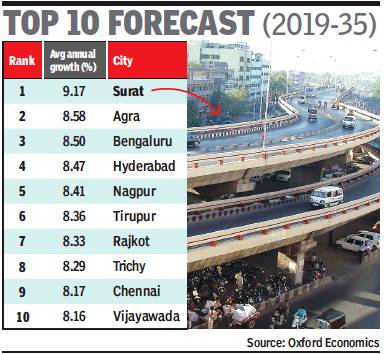
From: Surojit Gupta, ‘17 of 20 fastest-growing cities in the world will be from India’, December 7, 2018: The Times of India
Surat, Agra And Bengaluru To Make Up Top 3
The list of cities expected to grow the fastest in terms of GDP is dominated by India, with 17 among the top 20 cities in the world, according to a global economic research report.
“When future GDP growth rates are compared, the story is mostly very different. In particular, 17 of the 20 fastest-growing cities in the world between 2019 and 2035 will be Indian, with Bengaluru, Hyderabad and Chennai among the strongest performers,” said a report from Oxford Economics, a research house engaged in quantitative analysis.
Surat tops the list of top 10 fastest growing cities in the world between 2019 and 2035, followed by Agra and Bengaluru. Hyderabad is in fourth place, followed by Nagpur, Tirupur, Rajkot, Tiruchirappalli, Chennai and Vijayawada. Surat is a major diamond trading and processing centre and also has a strong IT sector.
Bengaluru, Hyderabad and Chennai are best known as technology hubs and home to large financial services firms. Outside of India, Phnom Penh is the fastestgrowing city in the world in the 2019-2035 forecast, with Dar es Salaam the leader among African cities.
In terms of population in 2035, Mumbai figures in the top 10 cities. “By 2035, the combined GDP of Indian cities will still be small compared with Chinese (or, indeed, North American and European) cities. However, in terms of GDP growth, it is Indian cities that are star performers in our forecast,” said Richard Holt, head of global cities research at Oxford Economics.
NY to remain largest urban eco: Study
However, Chinese cities will contribute significantly when it comes to aggregate GDP.
Shanghai will join London as the world’s fourth-largest urban economy in 2035.
According to the forecast, in 2027, the aggregate GDP of all Asian cities will for the first time exceed the combined GDP of all North American and European cities.
“By 2035, we project it will be 17% higher, with Chinese cities alone generating more output than all cities in North America or Europe,” the report said.
New York will still be the largest urban economy in the world in 2035, with the largest finance and business services sector. It will be followed by Tokyo and Los Angeles, with Shanghai tied with London for the fourth place, the report said. The research house said the modelling and results in the report were based on information provided by third parties, “upon which Oxford Economics has relied in producing its report and forecasts in good faith”.
[edit] B
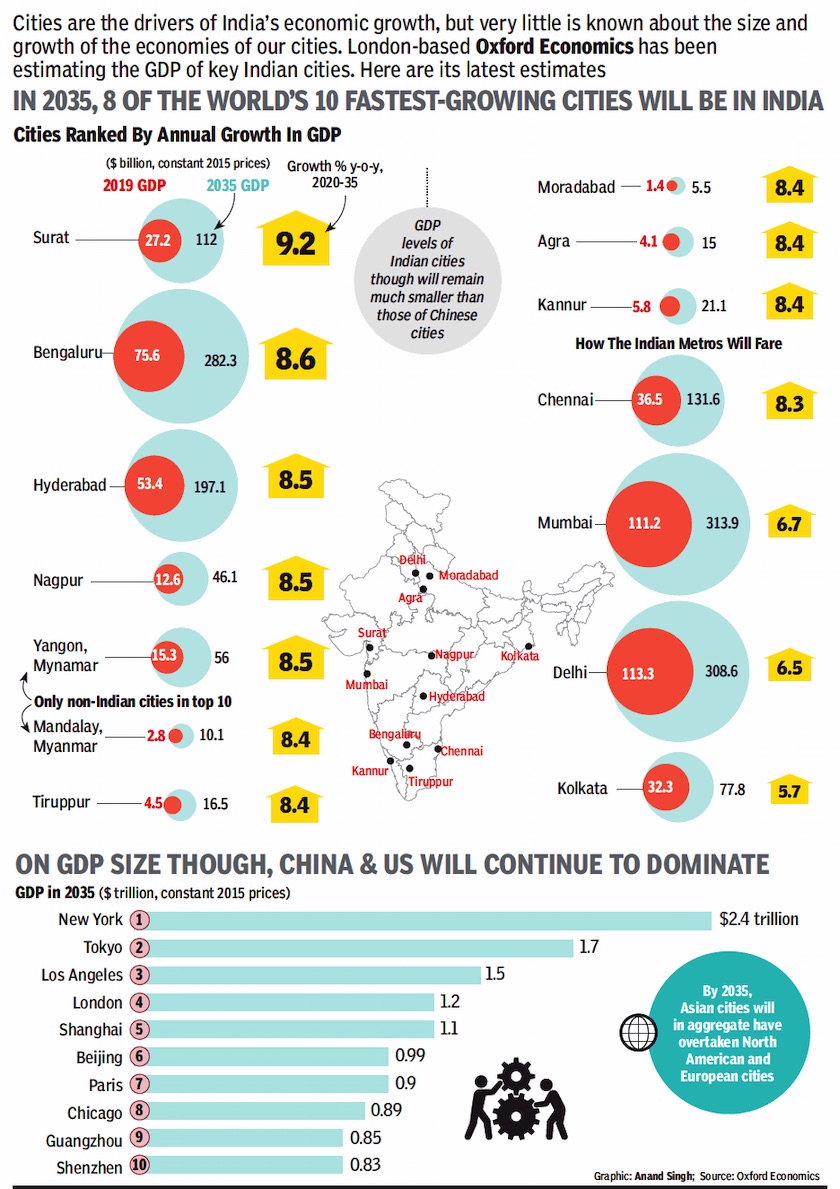
From: Dec 27, 2019 The Times of India
See graphic:
The Indian (and international) cities projected to grow the fastest between 2019 and 2035
[edit] Air services as a developmental indicator
WHAT FLIGHTS TO A MEGACITY TELL US ABOUT ITS ECONOMY, August 17, 2018: The Times of India

ii) The growth of the population of these cities, vis-à-vis the growth of their economies;
From: WHAT FLIGHTS TO A MEGACITY TELL US ABOUT ITS ECONOMY, August 17, 2018: The Times of India
A city is often measured in terms of its GDP, trade, investment. Another way is also to look at the frequency of flights in and out of there. Such a study of flight traffic by The Pudding shows how cities remain unconnected and underdeveloped though growing in number of inhabitants. Population growth without economic growth is ending up creating unsustainable megacities that can neither feed nor house its people. Here’s why a growing city isn’t always good news…
[edit] See also
Cities of India: the best and the worst
Cleanliness ranks of Indian cities, districts: 2014-15
Cleanliness ranks of Indian cities, districts: 2016
Cleanliness ranks of Indian cities, districts: 2017
Cleanliness ranks of Indian cities, districts: 2018
Cities of India: growth
